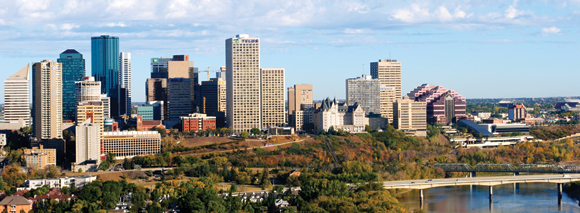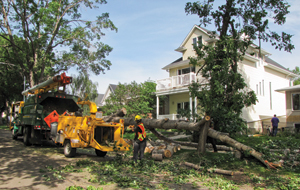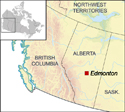Edmonton’s Urban Forest Management Plan

Photo courtesy of Cathy Talarico
MANAGING URBAN FORESTS IN A CHANGING CLIMATE
Edmonton, Alberta, has 299 000 landscape trees on City property, including boulevards and parks. These trees provide a plethora of valuable ecological services to the City. They keep neighbourhoods cool, improve air quality, provide wildlife habitat, remove carbon dioxide from the atmosphere, retain stormwater run off and prevent erosion. In addition, trees add substantial aesthetic, recreational and economic value to communities. However, this valuable asset is at risk because recent drought, insect infestations, disease and storms are taking a heavy toll on Edmonton’s extensive urban tree canopy.
In the last decade, more than 30 000 trees (an average of 4300 annually) died because of drought conditions and secondary pests, compared with a previously more typical number of losses of between 600 and 900 annually. The scale and intensity of the drought-related tree deaths are a major challenge for the City. Even with a capital infusion of $2.75 million to augment replanting efforts in 2003–2004 and the City’s desire to replace every felled tree, the City has been unable to keep pace with the recent losses.
Climate change is expected to further increase the threats to the health and viability of Edmonton’s urban tree canopy. If summer drought conditions continue, the City will need to intensify replanting efforts and reconsider which tree species to plant to reduce losses. Edmonton is also preparing for a wave from the south of invasive pests and diseases, including the Emerald Ash Borer and Dutch Elm Disease. These are major threats to the urban tree canopy because green ash and American elms comprise approximately 46 percent and 32 percent, respectively, of the City’s street trees.
These threats to the urban forest spurred the City to create a plan that would guide its future management over a 10-year period. In 2006, council approved the creation of a new staff position to lead the development of the City’s first Urban Forest Management Plan (UFMP). The plan, due in 2010, includes a vision statement, three main objectives, associated strategies and specific actions. The plan’s vision is “to have a diverse and sustainable urban forest that enhances the beauty of Edmonton and contributes to the well-being and quality of life for future generations.”
| Year | Lost | Planted |
|---|---|---|
| 2002 | 4300 | 1000 |
| 2003 | 5200 | 1800 |
| 2004 | 6200 | 1600 |
| 2005 | 4300 | 800 |
| 2006 | 3000 | 2050 |
| 2007 | 3400 | 1400 |
| 2008 | 4100 | 2450 |
| 2009 | 2977 | 2600 |
Each action has been assigned to a project partner and has a prioritized timeline: short (0 to 3 years), medium (4 to 7 years) and long (8 to 10 years). The following are examples of the key actions:
- Create an inventory of the urban forest (completed 2009).
- Develop a replacement strategy for dead or dying plant material.
- Review existing planting strategies.
- Create fire and disaster management plans.
- Develop a disease control plan.
- Assess staffing levels and staff training.
- Develop potential tree planting partnerships.
- Create public education opportunities
- Perform an Urban Forest Effects Model and a Street Tree Resource Analysis for Urban Forest managers (completed).
Three main objectives of the Urban Forest Management Plan
- To provide Edmonton with a comprehensive plan for effectively managing, sustaining and ensuring the growth of the City’s urban forest
- To educate the general public, other city agencies, neighbouring communities and community partners about the importance of the urban forest, forestry issues and management best practices
- To protect native forest and tree stands in conjunction with the city’s Office of Natural Areas, which is responsible for the natural areas and the Natural Connections Strategic Plan
The plan was developed with regular input and direction from a multi-stakeholder advisory group that included members of the public and affected interest groups, such as the City’s transportation and drainage personnel. An outcomes-based systems approach was used to define measures to assess progress toward the vision and the objectives. Forestry staff began the planning process by conducting an extensive review of best practice urban forest management plans from across North America. At various points in the process, the public was consulted through surveys, online information sharing and focus groups.
 Photo courtesty of Dailey O'Cain
Photo courtesty of Dailey O'Cain
An inventory of the urban forest, encompassing both private and public lands, is a key component of the UFMP. In 2009, extensive field observations combined with meteorological and pollution records were used to calculate the species composition of the urban forest as well as its economic and ecological value. This database provides an accurate baseline for the management of various threats to the urban canopy, including those related to a changing climate.
Edmonton’s Forestry Unit is actively testing different strategies and techniques to minimize the threats from climate change as well as take advantage of new opportunities. The City’s Old Man Creek Nursery, in partnership with a local private nursery, is conducting tree hardiness trials to test species such as red maples, crabapples, oaks and pears that are not usually planted in Edmonton but have increasing survival potential because of warming climate conditions. In addition, the Forestry Unit is testing alternative maintenance techniques to minimize losses from drought. These include watering methods such as the installation of water bags that slowly release water to the base of trees.
City officials note that a key strength of the UFMP plan-making process has been the Forestry Unit’s collaborative approach with other municipal departments and the public. Collaborative computer software has been an important tool for coordinating meetings, sharing data and distributing draft plans. However, the successful implementation of the plan’s actions rests on the continued engagement of stakeholders.
Half of Edmonton’s trees are on private property. To encourage a healthy tree canopy while also minimizing costs to the City, municipal officials will need to provide ongoing education and other services to the public. In addition, coordination between municipal departments is critical in responding to evolving climate and pest conditions. One example is a joint project between the Forestry Division and Public Works that is studying the feasibility of storing stormwater for use by trees during drought periods.
Edmonton’s tree canopy is seriously threatened by climate change, natural disasters, pests and disease. While the UFMP is still in its final draft stage, it has already enabled the City to develop a comprehensive and integrated approach to managing the urban forest. City officials look forward to continuing the work with various public and private stakeholders to implement best practice solutions to minimize, and hopefully reverse, the trend of high tree losses observed over the last decade.
Contact:
Jenny Wheeler Principal of Forestry, City of Edmonton Tel.: 780-442-0224 E-mail: Jeannette.Wheeler@Edmonton.ca
Page details
- Date modified:
